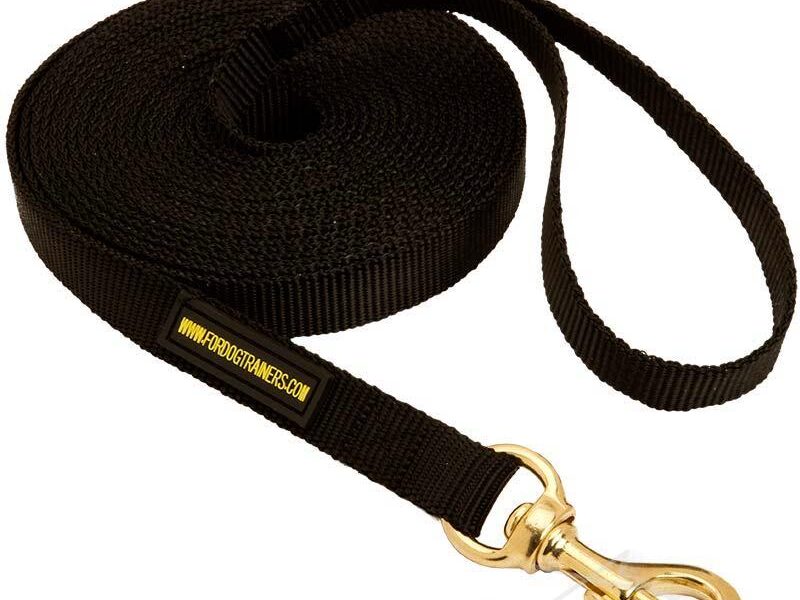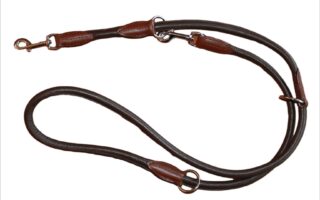The Long Leash: Unleashing Possibilities in Training Adventures
In the realm of dog training, the simplest tools often pave the way for the most profound transformations. Among them stands the long training leash, a versatile companion that not only extends the physical reach between owner and pet but also broadens the horizons of obedience and exploration. This unassuming piece of equipment, typically stretching anywhere from 15 to 50 feet, opens up a world of possibilities for both puppies and seasoned dogs alike. In this article, we will delve into the myriad ways a long training leash can enhance your training experience—offering freedom while still maintaining control, fostering trust, and encouraging play. Whether you’re introducing a new trick or reinforcing recall commands, the long leash serves as a gateway to building a stronger bond and a confident canine companion. Join us as we explore the benefits, best practices, and tips for incorporating this essential tool into your training regimen.
Table of Contents
- Understanding the Benefits of a Long Training Leash for Dog Owners
- Choosing the Right Material and Length for Optimal Training Results
- Effective Techniques for Using a Long Training Leash in Various Settings
- Safety Tips to Enhance Training Sessions with a Long Leash
- Q&A
- Closing Remarks
Understanding the Benefits of a Long Training Leash for Dog Owners
A long training leash is an invaluable tool for dog owners looking to enhance their training sessions while allowing their furry companions the freedom to explore. With lengths typically ranging from 15 to 50 feet, these leashes provide a balance of control and liberty, giving dogs the chance to roam in safe environments without the risk of them running away. Key advantages include:
- Encouraged Exploring: Dogs can enjoy their surroundings while still under your guidance, promoting natural behaviors.
- Improved Recall Training: A long leash helps reinforce the ‘come’ command, as dogs learn to return to you while feeling secure.
- Varied Training Opportunities: Owners can implement various training exercises, such as loose-leash walking or agility drills, with the added distance.
- Greater Safety: Provides an extra sense of security during outdoor adventures, especially in parks or unfamiliar areas.
Moreover, a long training leash fosters a stronger bond between you and your dog. It allows them the freedom to engage with their surroundings while still being anchored to their owner. This interaction enhances trust and communication, as they learn to focus on you amidst distractions. To visualize the interplay of factors that can enhance training, consider the following:
| Training Focus | Leash Length | Best Practices |
|---|---|---|
| Recall Training | 30-50 feet | Practice in open spaces to minimize distractions. |
| Loose-leash Walking | 15-30 feet | Start in familiar areas, gradually introducing more distractions. |
| Agility Exercises | 20-40 feet | Set up obstacles with the leash allowing moderate freedom to maneuver. |
Choosing the Right Material and Length for Optimal Training Results
When selecting a training leash, the material plays a significant role in durability, comfort, and effectiveness. Different materials offer various benefits, so it’s essential to consider what best suits your training needs. Nylon leashes are lightweight and affordable, making them a popular choice for everyday training. They come in a broad range of colors and lengths, perfect for personalizing your dog’s gear. Leather, while often more expensive, provides added durability and a classic look. This material offers a better grip and is softer on the hands during extended training sessions. Also, consider cotton webbing for a balance between comfort and sturdiness, providing a gentler feel while still being robust enough for active dogs.
The length of the leash can also dramatically impact your training effectiveness. A leash that is 15 to 30 feet long is ideal for recall training, allowing your dog a greater area to explore while still giving you control. For more structured training sessions, 6 feet is often the recommended length, as it helps reinforce the connection between you and your dog, limiting distractions. In more open areas, such as parks, consider using a 30-foot or longer leash to give your dog freedom while maintaining safety. Ultimately, the right material and length not only enhance training but also contribute to fulfilling the bond between you and your furry companion.
| Material | Durability | Comfort | Best Use |
|---|---|---|---|
| Nylon | Medium | Good | Everyday training |
| Leather | High | Excellent | Long sessions |
| Cotton Webbing | Medium | Very Good | General use |
Effective Techniques for Using a Long Training Leash in Various Settings
Using a long training leash effectively requires understanding both the tool and your environment. In open spaces like parks or fields, the leash allows dogs more freedom to explore while staying connected. This can encourage natural behaviors such as sniffing and roaming, which are essential for their mental stimulation. To make the most out of this setting, consider the following techniques:
- Practice recall commands: Give your dog plenty of space to run, then call them back to you. Reward them with treats when they obey.
- Implement focus exercises: Use the leash to help your dog learn to focus on you amid distractions. Reward them when they maintain eye contact.
- Incorporate play sessions: Engage with your dog using toys or other distractions while keeping them leashed, teaching them the boundaries of playtime.
In more confined areas, such as urban settings where space is limited, adapt your approach to teach loose-leash walking and socialization. The long leash can be an asset in busy environments, helping to maintain control while allowing some leeway. Consider these strategies for training in such situations:
- Set clear walking boundaries: Use the leash to establish a comfortable distance from people and other dogs. Reinforce this behavior with positive reinforcement.
- Teach ‘leave it’ commands: With a longer leash, you can practice teaching your dog to ignore distractions, which is crucial in bustling urban areas.
- Socialization drills: Slowly introduce your dog to other people and pets while maintaining a safe distance. Gradually decrease the distance as they become more comfortable.
Safety Tips to Enhance Training Sessions with a Long Leash
Utilizing a long training leash effectively requires a focus on safety to ensure a positive experience for both you and your dog. To start, make sure to choose a leash that is appropriate for your dog’s size and strength. Opt for a material that is durable yet lightweight, which enables easy handling during training. As you engage in training exercises, be aware of your surroundings to prevent accidents or unexpected encounters with other dogs or people. Always maintain a firm grip on the leash to have maximum control over your dog’s actions.
Another essential aspect of incorporating a long training leash is to establish a clear set of commands and signals. This promotes effective communication between you and your dog, enhancing their learning experience. Before initiating a training session, perform a quick safety check that includes:
| Item | Status |
| Leash condition | Check for wear and tear |
| Collar/harness fit | Ensure it’s snug yet comfortable |
| Training area | Inspect for distractions or hazards |
By focusing on both equipment quality and environmental awareness, you can significantly increase the safety of your training sessions, allowing for more effective learning and bonding time with your canine companion.
Q&A
Q&A: Understanding the Long Training Leash
Q1: What is a long training leash and what is its main purpose?
A1: A long training leash is a type of dog leash that typically ranges from 15 to 50 feet in length. Its primary purpose is to provide dogs with a safe way to explore their environment while still maintaining control. This allows for greater freedom of movement compared to a standard leash, making it ideal for training recall, enhancing socialization, and practicing commands in an open area.
Q2: How is a long training leash different from a regular leash?
A2: Unlike a regular leash, which usually spans 4 to 6 feet, a long training leash offers a much longer reach, allowing dogs to roam more freely. This added length is particularly useful in training scenarios where a dog needs to build confidence and learn boundaries without the immediate constraint of a shorter leash. Additionally, long training leashes are usually made from durable materials to withstand a dog’s tugging and pulling.
Q3: What are the benefits of using a long training leash?
A3: The benefits of a long training leash are numerous! It encourages safer exploration and play, assists in effective recall training, helps with socialization in various settings, and allows trainers to establish boundaries while still giving dogs the freedom to roam. This leash also comes in handy for teaching commands like ”stay,” “sit,” and “come,” all while ensuring the dog remains within a controlled distance.
Q4: Are there any disadvantages to using a long training leash?
A4: While long training leashes offer great benefits, there are some disadvantages to consider. They can become cumbersome for the handler, especially in crowded areas or when managing multiple dogs. Additionally, there’s a risk of tangling, particularly in environments with obstacles. It’s also essential to be aware of your surroundings, as the extended length may inadvertently lead to unexpected interactions with other pets or people.
Q5: How should one train a dog using a long training leash?
A5: Training with a long leash should start in a safe, open area with minimal distractions. Begin by letting the dog explore while keeping the leash loose, which allows them to feel more relaxed. Use positive reinforcement, like treats or praise, to encourage desired behaviors. Gradually introduce commands like “come” while using the leash to guide them back to you. Remember to gradually reduce the distance and reliance on the leash as your dog becomes more proficient with commands.
Q6: Can any dog be trained with a long training leash?
A6: In general, most dogs can be trained with a long training leash, but particular attention should be given to their temperament and energy levels. High-energy or easily distracted dogs may require more supervision and control, while calmer breeds may benefit greatly from the extended exercise. It’s important for owners to assess their dog’s personality and previous training experience before starting.
Q7: How can one choose the right long training leash?
A7: When selecting a long training leash, consider factors like the material (nylon or cotton are common choices), durability, weight, and length. Opt for a leash that feels comfortable in your hand and suits your dog’s size and strength. Additionally, consider the hardware on the leash—look for a sturdy clip that can withstand pulling. Lastly, if you’re training in varied environments, a leash with reflective materials or additional padding can enhance your experience.
Q8: Is a long training leash suitable for all training scenarios?
A8: While a long training leash is incredibly versatile, it may not be suitable for all situations. In crowded or busy environments, a shorter leash might be safer to manage sudden reactions or distractions. Additionally, introducing new commands or behaviors could be more effectively handled with a shorter leash initially. Ultimately, assessing the training context and your dog’s individual needs is key to deciding whether a long training leash is the best choice.
Whether you are a seasoned trainer or a dog owner looking to enhance your pet’s training experience, a long training leash can be a valuable tool in fostering a positive relationship between you and your furry friend.
Closing Remarks
As we wrap up our exploration of the long training leash, it’s clear that this simple tool can open up a world of possibilities for both dogs and their handlers. From enhancing communication to fostering freedom, the long leash serves as a bridge between control and adventure. Armed with the knowledge of its benefits and the considerations to keep in mind, you are now better equipped to embark on your training journey. Whether you’re teaching recall, practicing commands, or simply enjoying the great outdoors, the long training leash can be a valuable ally. So, as you take those next steps with your furry companion, remember: every stretch of that leash holds the potential for growth, discovery, and deeper connection. Happy training!



